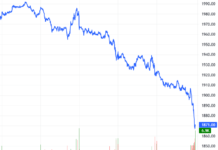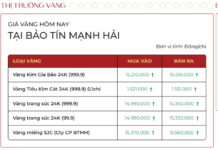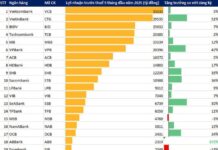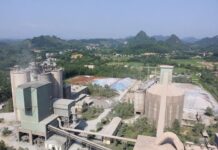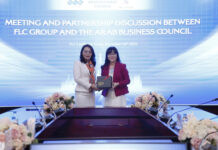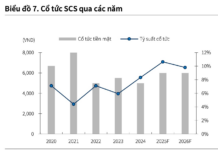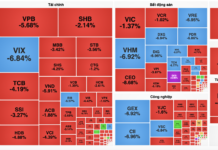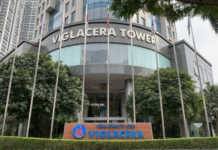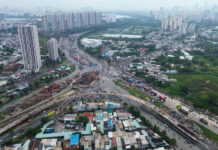At the meeting on socio-economic situation of Ho Chi Minh City on the afternoon of August 1st, Mr. Vo Van Hoan, Vice Chairman of the Ho Chi Chi Minh City People’s Committee, said that the new land price framework has been attracting great attention from the public. As this information affects many subjects, it needs to be carefully discussed and considered.
According to Mr. Hoan, there are many aspects to discuss regarding the new land price framework. “We have to be thorough and provide clear answers to ensure public understanding. For any negative impacts or consequences, we must find a solution,” he emphasized.
Meanwhile, Mr. Nguyen Toan Thang, Director of the Ho Chi Minh City Department of Natural Resources and Environment, stated that among the contents to be deployed under the 2024 Land Law, the People’s Committee of the provincial level has the authority to consider and use the old land price framework or adjust it. Accordingly, Ho Chi Minh City has decided to adjust the old land price framework.
The adjustment of the land price framework consists of seven steps. So far, the Department of Natural Resources and Environment has completed six steps, and all data collected by the consulting unit across the city has been calibrated and transferred to the assisting group of the Ho Chi Minh City People’s Council for consideration and appraisal.
“Let me clarify that this land price framework is an adjustment, and we have not yet developed a new land price framework under the 2024 Land Law. The new land price framework will be constructed and applied from January 1, 2026. The current adjustment is to update the old prices, taking into account current market prices, approved compensation prices, and specific market prices to prevent losses due to the old prices being too low,” said Mr. Thang.
The Director of the Department of Natural Resources and Environment cited examples of streets where the old land price framework set the price at only VND 1-2 million per square meter, while the current transaction price has reached VND 120 million per square meter. Therefore, this update aims to calibrate and provide the most suitable land price framework for Ho Chi Minh City.

This land price framework is an adjustment, and Ho Chi Minh City has not yet developed a new land price framework under the 2024 Land Law. |
Previously, the Ho Chi Minh City Department of Natural Resources and Environment announced a draft decision to adjust Decision No. 02/2020/QD-UBND dated January 16, 2020, on the land price framework in the city.
According to the draft, the highest land price in Ho Chi Minh City’s urban areas is VND 810 million per square meter, located in central streets such as Dong Khoi, Nguyen Hue, and Le Loi in District 1. Compared to the current land price framework, the proposed prices are five times higher.
Some adjacent streets, such as Ton Duc Thang Street (from Me Linh Square to Nguyen Tat Thanh Bridge), are priced at VND 528 million, an increase of VND 422.4 million per square meter compared to the current land price framework. Similarly, Pham Hong Thai Street is priced at VND 418 million per square meter, an increase of VND 334.4 million.
In Thu Duc City, the current land price framework ranges from VND 5-7 million per square meter, with some areas exceeding VND 20 million per square meter. With the proposed adjustments, prices will increase by tens of times. For example, Tran Nao Street is expected to be priced at VND 149 million per square meter, while the current framework sets the price between VND 13-22 million per square meter.
Streets in Thao Dien Ward, which previously had prices of around VND 7.8 million per square meter, are expected to increase to VND 88-120 million per square meter. Street 13, Ward 4 (An Phu Ward) will see a rise from VND 5.2 million per square meter to VND 91 million per square meter (a 17.5-fold increase).
Similarly, many streets in Districts 7, 4, and 12 are expected to be adjusted with prices increasing by 10-15 times compared to the current land price framework.
In the districts of Nha Be, Binh Chanh, Can Gio, and Cu Chi, the proposed adjustments show prices increasing by 10-20 times compared to the land price framework decided in Decision No. 02/2020/QD-UBND dated January 16, 2020.
Hoc Mon district stands out with the highest expected price adjustments compared to the old land price framework, with some streets experiencing increases of over 15-50 times. For example, the price of Do Van Day Street, from Xang Bridge to Lang Cha Three-Way Junction, is set to rise from VND 780,000 per square meter to VND 24.1 million per square meter, while Nguyen Thi Thanh Street, from Dang Thuc Vinh Street to Tran Quang Co Canal, is expected to increase by more than 37 times, from VND 610,000 to VND 22.4 million per square meter.
|
Regarding the 2024 Land Law, Mr. Nguyen Toan Thang stated that Ho Chi Minh City’s authority includes providing recommendations for issuing 14 documents with detailed guidelines and appendices. The city’s policy is to allow a streamlined process, and by August 1, the deadline for collecting feedback from units will have been met. By August 15, all 14 documents must be issued to ensure the implementation of the Land Law. One of the 14 documents to be issued includes the authorization for the People’s Committee at the provincial level to consider and adjust the land price framework. Based on this, Ho Chi Minh City has decided to adjust the old land price framework. |
Duy Quang

